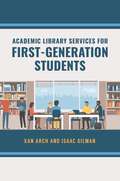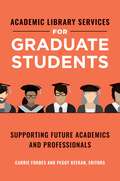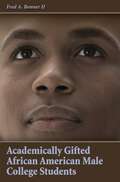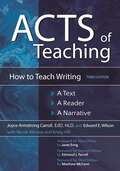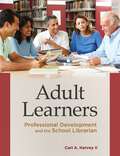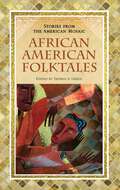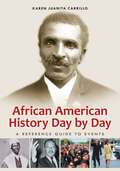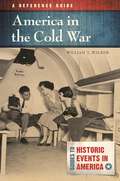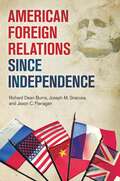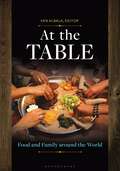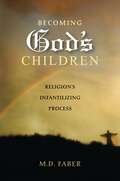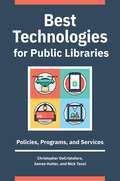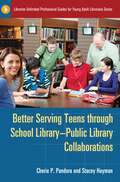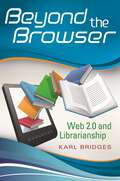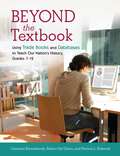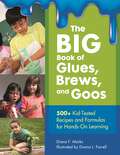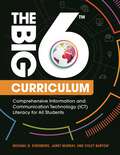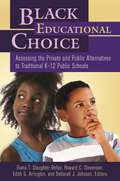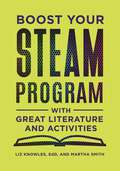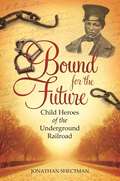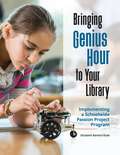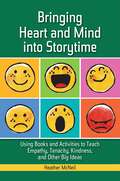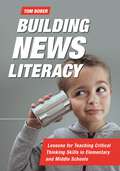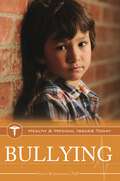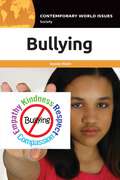- Table View
- List View
Academic Library Services for First-Generation Students
by Xan Arch Isaac GilmanPresenting strategies for improving academic library services for first-generation students, this timely book focuses on programs and services that will increase student academic engagement and success.Demographic data and secondary school graduation rates suggest that colleges and universities will enroll growing numbers of first-generation students over the next decade. Academic Library Services for First-Generation Students focuses on ways academic libraries can uniquely contribute to the successful transition to college and year-to-year retention of first-generation students. The practical recommendations in this book include a wide range of ideas for the design and modification of library services and facilities to be more inclusive of the needs of first-generation students. All of the recommendations are specifically aimed at addressing challenges faced by first-generation students. Topics covered range from study spaces and service points to information literacy instruction and campus partnerships. The book makes the case—both explicitly and implicitly—that academic libraries can help address known risk factors (e.g., by helping students build academic cultural competencies) and thereby improve success, persistence, and retention for first-generation students. Academic library professionals in both leadership roles and public service positions will benefit from the actionable strategies presented here.
Academic Library Services for Graduate Students: Supporting Future Academics and Professionals
by Carrie Forbes and Peggy KeeranProviding practical and theoretical chapters on academic library services for graduate students, this volume helps information professionals support this often-overlooked campus population to address their multiple roles and identities as students and as future faculty members or professionals.As more and more students attend graduate programs, many higher education institutions have established professional development programs to help graduate students learn the wide range of skills needed to be successful as both students and as future professionals or academics. To presuppose that graduate students are proficient library users is a mistake. Graduate students need and want help, and many libraries are now offering specialized services for this diverse population. Contributors to this edited volume provide case studies and practical advice on academic library services for graduate students that support their multiple roles on campus and address the complex social and emotional issues related to their other roles as parents, working adults, caretakers, and more. As academic libraries shift from functioning primarily as collections repositories to collaborating as key players in discovery and knowledge creation, value-added services for graduate students are even more central to libraries' changing missions. This book makes an important contribution to the ongoing professional conversation and is a useful tool for librarians who want to better support graduate students at their institutions.
Academically Gifted African American Male College Students
by Fred A. IIThe first-ever study of African American giftedness at the collegiate level, focusing on two extraordinary case studies.At a time when so many studies of African American students focus on the factors of failure, Academically Gifted African American Male College Students fills a conspicuous void in the research literature on post-secondary education by focusing on success. Like no other work before it, this remarkable study goes deep inside the experiences of academically gifted African American men who successfully navigate their way through rigorous college-level programs.At the heart of the unique and long overdue work are two real-life stories of African American male students: one at a Historically Black College and University (HBCU) and the other at a Traditionally White Institution (TWI). In presenting, comparing, and contrasting these two cases, the book identifies a number of personal characteristics and institutional approaches driving their notable achievements. The result is a guidebook both for gifted African American male students and for the institutions looking to strengthen their support for them—particularly in science, technology, engineering, and mathematics (STEM) disciplines.
Acts of Teaching: How to Teach Writing: A Text, A Reader, A Narrative
by Joyce Armstrong Carroll Edward E. Wilson Nicole Klimow Kristy HillInclusive of the scope and authoritative references from earlier editions, this edition additionally embraces the digital world and provides practical suggestions for performing the "act of teaching."Teachers of writing at all levels will applaud this edition for its new features designed to help teachers to understand and teach to today's new paradigms in writing. New to this edition are two chapters on cognition and technology, respectively; a chapter on early literacy, with student samples; and, for the first time, an online connection that links readers to important articles, visuals, and resources. Essay writing is explored through discussion of the thesis and its criteria; five organizational patterns for the expository essay; and distinctions among the opinion, persuasive, and argumentative essay. Several new prewriting strategies are also provided: A Sense Notebook, Looking, Contouring, an expanded explanation of Blueprinting, and a discussion of a hierarchical approach to organization.
Adult Learners: Professional Development and the School Librarian
by Carl A. IIThis practical guide clarifies why school librarians need to be part of the professional development process in their schools—and shows just how to achieve that goal.To remain gainfully employed, today's school librarian has to be a leader in the school. To that end, Adult Learners: Professional Development and the School Librarian encourages librarians to become instrumental in providing professional development to teachers and staff. The book begins by explaining why librarians should participate in designing and presenting professional development, then goes on to provide tips, examples, and a complete model for doing this based on system used at the author's school. Readers will discover how to determine what is practical and how to turn ideas into actions, whether they want to implement a major initiative or start with something small. Most important, this book details how to become part of the professional development team in ways that are both relevant and meaningful to the teachers and staff involved. When these stakeholders understand what the librarian knows and how they can benefit, the librarian's sphere of influence will be expanded—and a job just might be saved.
African American Folktales (Stories from the American Mosaic)
by Thomas A. GreenAfrican American culture has a rich tradition of folktales. Written for students and general readers, this volume gathers a sampling of the most important African American folktales. Included are nearly 50 tales grouped in thematic chapters on origins; heroes, heroines, villains, and fools; society and conflict; and the supernatural. Each tale begins with an introductory headnote, and the book closes with a selected, general bibliography. Students learning about literature and language will gain a greater understanding of African American oral traditions, while social studies students will learn more about African American culture.African American culture has long been recognized for its richness and breadth. Central to that tradition is a large body of folklore, which continues to figure prominently in literature, film, and popular culture. Written for students and general readers, this book conveniently gathers and comments on nearly 50 African American folktales. Included are fictional tales, legends, myths, and personal experience narratives. These exemplify the vast diversity of African American culture and language.The tales are grouped in thematic sections on origins; heroes, heroines, villains, and fools; society and conflict; and the supernatural. Each tale is introduced by a brief headnote, and the volume closes with a selected, general bibliography. Students learning about literature and language will gain a greater understanding of African American oral traditions, while students of history will learn more about African American culture.
African American History Day by Day: A Reference Guide to Events
by Karen Juanita CarrilloThe proof of any group's importance to history is in the detail, a fact made plain by this informative book's day-by-day documentation of the impact of African Americans on life in the United States.One of the easiest ways to grasp any aspect of history is to look at it as a continuum. African American History Day by Day: A Reference Guide to Events provides just such an opportunity. Organized in the form of a calendar, this book allows readers to see the dates of famous births, deaths, and events that have affected the lives of African Americans and, by extension, of America as a whole.Each day features an entry with information about an important event that occurred on that date. Background on the highlighted event is provided, along with a link to at least one primary source document and references to books and websites that can provide more information. While there are other calendars of African American history, this one is set apart by its level of academic detail. It is not only a calendar, but also an easy-to-use reference and learning tool.
America in the Cold War: A Reference Guide (Guides to Historic Events in America)
by William T. WalkerIncluding extensive, balanced information, keen insights, and helpful research tools, this book provides a valuable resource for students or general readers interested in American policy, diplomacy, and conduct during the Cold War.The Cold War not only comprised the dominant theme in American foreign policy during the second half of the 20th century; its influence was also imbedded into American culture. The half-century duration of the Cold War was an extended learning period during which the United States found that it could no longer remain an isolationist nation in a complex, quickly evolving, and dangerous world. This book covers the entire scope of the Cold War, from its background and origins before and after World War II to the collapse of the Soviet Union on December 25, 1991, providing coverage of key events and concepts, such as the containment policy, McCarthyism, the Cuban Missile Crisis, the Vietnam War, détente, and nuclear arms policies. The single-volume work also provides an annotated bibliography, primary documents, and biographies of key personalities during the Cold War, such as John Foster Dulles, J. Edgar Hoover, George F. Kennan, Henry Kissinger, Edward R. Murrow, and Ronald Reagan.
American Foreign Relations since Independence
by Richard Dean Burns Joseph M. Siracusa Jason C. FlanaganThis book provides a succinct and accessible interpretation of the major event and ideas that have shaped U.S. foreign relations since the American Revolution—historical factors that now affect our current debates and commitments in the Middle East as well as Europe and Asia.American Foreign Relations since Independence explores the relationship of American policies to national interest and the limits of the nation's power, reinterpreting the nature and history of American foreign relations.The book brings together the collective knowledge of three generations of diplomatic historians to create a readily accessible introduction to the subject. The authors explicitly challenge and reject the perennial debates about isolationism versus internationalism, instead asserting that American foreign relations have been characterized by the permanent tension inherent in America's desire to engage with the world and its equally powerful determination to avoid "entanglement" in the world's troubles. This work is ideally suited as a resource for students of politics, international affairs, and history, and it will provide compelling insights for informed general readers.
At the Table: Food and Family around the World
by Editor Ken AlbalaWhat's for dinner? Not just in America, but around the world? And how is it cooked, what's the historical significance of that food, how is it served and consumed, and who gets to clean up? This book provides fascinating insight into how dinner is defined in countries around the world.Almost universally, "dinner" is a key meal in most countries around the world, whether it be a simple dish of rice and beans, a slice of pizza on the go, or a multi-course formal meal. What do the specifics of how a meal is eaten—by hand instead of with utensils, for example—say about a specific culture? This fascinating one-volume reference guide examines all aspects of dinner in international settings, enabling insightful cross-cultural comparisons and an understanding of the effects of modernization and globalization on food habits.Some 50 countries are covered in chapters focusing on present-day meal habits in Europe, Asia, the Middle East, Africa, and North and South America. The commentary covers everything about the meal, such as the time, the cooking and preparation, shopping for ingredients, the clean-up process, gender-based participation roles, conversation or other social interactions, and etiquette—just about everything that happens at the table. The book is ideal for classroom teaching and learning, as the entries and photos are conducive to teaching students about other cultures, directly supporting the National Geography Standards. Students will be able to make informed comparisons between their own lives and the various cultural experiences described in the book.
Becoming God's Children: Religion's Infantilizing Process
by M. D. FaberM. D. Faber presents a meticulous, unremitting inquiry into the psychological direction from which Christianity derives its power to attract and hold its followers.Becoming God's Children: Religion's Infantilizing Process was written, its author says, to alert readers to the role of infantilization in the Judeo-Christian tradition generally and in Christian rite and doctrine particularly. Because religion plays such an important role in so may lives, it is essential to understand the underlying appeal and significance of religious doctrines.To that end, Becoming God's Children offers the reader an in-depth account of human neuropsychological development, while unearthing the Judeo-Christian tradition's explicitly infantilizing doctrines and rites. This compelling perspective on the nature and meaning of religious behavior explores issues such as: to what extent religious faith is grounded in the mnemonic recesses of the worshipper's brain, whether believers are predisposed by both genetic makeup and environmental prompting to adhere to their religious convictions, and why some individuals are powerfully drawn to religious faith while others reject it. A final chapter explores the implications of religion's infantilizing process vis-a-vis the role of reason and scientific thought in the contemporary world.
Best Technologies for Public Libraries: Policies, Programs, and Services
by Christopher DeCristofaro James Hutter Nick TanziEmerging technologies can intimidate with their cost and uncertainty—this book provides flexible options for adopting the most popular ones.Introducing new technologies to your library can be a daunting process; they can be costly, they may be unfamiliar to many staff members, and their success is far from assured. To address these concerns, Best Technologies for Public Libraries accommodates budgets large and small, providing options for both the ambitious and the cost-conscious. Authors Christopher DeCristofaro, James Hutter, and Nick Tanzi provide a resource for staff looking to incorporate a number of emerging technologies into their library and makerspaces. Each chapter explores a new technology, including 3D printing, drones, augmented reality, and virtual reality, covering how the technologies work, the selection process, training, sample programming, best practices, and relevant policy. By describing a variety of program and service ideas across age groups, the book gives readers the ability to first evaluate them within the context of their own organization before incorporating ideas à la carte. This approach helps readers to adopt these new technologies and create policies with uses already in mind.
Better Serving Teens through School Library–Public Library Collaborations (Libraries Unlimited Professional Guides for Young Adult Librarians Series)
by Cherie P. Pandora Stacey HaymanIn this practical guidebook, experienced librarians—a public librarian and a school librarian—share advice and ideas for extending resources, containing costs, and leveraging capabilities between school and public libraries, offering insights and strategies to overcome today's economic challenges.The current economic crisis has had a drastic impact on both public and school libraries. As budgets shrink, resources become scarcer, and the job of the librarian becomes harder. The conundrum of doing more with less challenges even the most seasoned professionals whose institutions face service cutbacks, disappointed patrons, and possible job eliminations or closures. This book asserts that a collaboration between school and public libraries can effectively serve the needs of two populations—teens and the community at large—while minimizing the cost to do so.Better Serving Teens through School Library–Public Library Collaborations offers thought-provoking advice and ideas for practical use in real-world libraries. The authors provide step-by-step guidance for those who wish to start, strengthen, or extend a partnership with colleagues at a sister library, covering topics ranging from teen advisory boards and collaborative programs to homework help and professional development. Veterans in the field, as well as beginners, can utilize the wealth of tools within—including worksheets, timelines, and checklists—to leverage the capabilities of other agencies tp fortify both their own and their institutions' value.
Beyond the Browser: Web 2.0 and Librarianship
by Karl BridgesAuthored by an experienced librarian, digital resource manager, and professor in the field of library science, this book explores the wide-reaching impact of second-generation web technologies on library organization and services—and how library staff must respond.Most librarians are infinitely familiar with the Internet due to their daily use of this essential resource. However, having practical expertise with today's digital resources does not guarantee the ability to speak intelligently and convincingly about their less-obvious benefits to funding authorities—an important skill to have. Beyond the Browser: Web 2.0 and Librarianship overviews the history of libraries and the Internet to provide necessary perspective and then examines current and future trends in libraries. In Part I, the author traces the notion of connectivity from its roots in the 19th century through the rise of digital technology in the second half of the 20th, concluding with a discussion of its influence on the role expectations and performance of today's information professional. Part II investigates the evolutionary impact of open access, scholarly inquiry, and second-generation web technologies on library organization and services. A bibliography of helpful resources is also included.
Beyond the Textbook: Using Trade Books and Databases to Teach Our Nation's History, Grades 7–12
by Carianne Bernadowski Patricia L. Kolencik Robert Del GrecoThis collection of standards-based lessons will guide middle and high school teachers while teaching the nation's history in a user-friendly, ready-made fashion.During a time of standards-based instruction, Beyond the Textbook: Using Trade Books and Databases to Teach Our Nation's History, Grades 7–12 will fill the gap in today's middle and high school classrooms to simultaneously engage students in effective literacy skill exercises and teach our nation's history. Authored by three experienced former public school teachers, these ready-made lesson plans for classroom teachers and school librarians make planning easy for implementation in a social studies, history, or English classroom. The book covers topics from Native Americans to the Louisiana Purchase, offering evidence-based reading strategies throughout that can hold adolescents' attention and develop their vocabulary and comprehension. Each chapter will include bibliographic information; suggested grade level; Information Literacy and National Social Studies Standards; before, during, and after reading strategies; database integration for classroom use; and suggested readalikes. Users will find the standards and evidenced-based research perfectly applicable in today's classrooms.
The BIG Book of Glues, Brews, and Goos: 500+ Kid-Tested Recipes and Formulas for Hands-On Learning
by Diana F. MarksThis compilation is a must-have for every library, providing a multitude of methods for developing easy, interesting activities for children. Projects across cultures, recipes for healthy snacks, and intriguing science experiments are among the hundreds of ideas connecting learning and creativity for students of all ages.Here's a book to help students create cross-disciplinary projects by using materials they make themselves. From clays and dough, to compounds and crystals, to healthy treats and snacks, children can access the formulas and recipes to make them all! This updated resource combines everything from the former two volumes into one comprehensive edition and features even more recipes, additional relevant content, and expanded connections between activities and curriculum. Every activity provides you with easy-to-follow, step-by-step directions. Each tried-and-true, safe concoction uses easily obtainable ingredients and provides suggestions for determining why and when each formula can be used. The book contains recommendations for linking projects to curriculum to help make each activity relevant and educational. Organized into 33 chapters, projects include making musical instruments, growing and using plants, conducting science experiments, and preparing food for ourselves and other creatures.
The Big6 Curriculum: Comprehensive Information and Communication Technology (ICT) Literacy for All Students
by Michael B. Eisenberg Janet Murray Colet BartowThis practical, hands-on book explains how to ensure that your students are information and communication technology literate—that is, competent with a range of tools, technologies, and techniques for seeking out and applying information.The importance of teaching information and communication technology (ICT) literacy is clear: without it, students will be ill-equipped to find and use information in all its forms as well as produce and present information in all forms. Unfortunately, most ICT literacy educational programs are irregular, incomplete, or arbitrary. Classroom teachers, teacher librarians, and technology teachers need a complete ICT program—one with clearly defined goals and objectives, planned and coordinated instruction, regular and objective assessment of learning, and formal reporting of results. This book explains how to integrate the objectives of ICT literacy into your school's established curricular structure.The book explains the rationale for a having a comprehensive ICT program, describes how to develop a Big6 by the Month program, and defines the challenges in the areas of information-seeking strategies, location and access, use of information, synthesis, and evaluation. It also includes templates for grade-level objectives; a scenario plan, program plan, lesson plan, and unit plan; summary evidence and criteria; performance descriptors; a presentation readiness checklist; and Big6 by the Month checklists for instructional leaders, teachers, and teacher librarians.
Black Educational Choice: Assessing the Private and Public Alternatives to Traditional K–12 Public Schools
by James A. BanksThis important book provides African American parents with the knowledge to diversify K–12 school choices beyond traditional neighborhood public schools in order to optimize the educational chances of their own children, and it will help educators and policymakers to close the black-white academic achievement gap throughout America.Closing the K–12 achievement gap is critical to the future welfare of African American individuals, families, and communities—and to the future of our nation as a whole. The black-white academic achievement gap—the significant statistical difference in academic performance between African American students and their white peers—is the single greatest impediment to achieving racial equality and social justice in America.Black Educational Choice provides parents, citizens, educators, and policymakers the critical knowledge they need to leverage the national trend toward increasing and diversifying K–12 school choice beyond traditional neighborhood public schools. Parents can use this information to optimize the success of their own African American children, while policymakers and educators can apply these insights to help close the black-white academic achievement gap throughout America. The book collects the interdisciplinary, multi-racial, and multi-ethnic perspectives of education experts to address the questions of millions of anxious African American families: "Would sending our children to a private school or a charter school significantly better their chances of closing the achievement gap and becoming successful individuals? And if so, what kinds of challenges would they likely experience in these alternative educational settings?"
Boost Your STEAM Program with Great Literature and Activities
by Liz Knowles Martha SmithYou've created a STEAM program in your library, but how do you work literacy into the curriculum? With this collection of resource recommendations, direction for program development, and activities, you'll have students reading proficiently in no time.Many schools and libraries are implementing STEAM programs in the school library makerspace to promote problem solving by allowing students to create their own solutions to a problem through trial and error. In order to enhance literacy development in the STEAM program, however, they need resources for integrating literature into the curriculum. In this collection of resources for doing just that, veteran education professionals and practiced coauthors Liz Knowles and Martha Smith bring readers over eight hundred recommended and annotated books and web resources, selected based on research on successfully integrating STEAM and literacy programs and organized by the five STEAM areas. Titles are complemented by discussion questions and problem-solving activities that will aid educators in both adding and using the best literature to their STEAM programs for encouraging learning. In addition to promoting literacy, these resources will help to develop creativity, lateral thinking skills, and confidence in students.
Bound for the Future: Child Heroes of the Underground Railroad
by Jonathan ShectmanThrough careful, detailed consideration of a host of primary documents about the young activists who formed the Underground Railroad's underappreciated operational workforce, this book offers fresh insight to the complex question, "Who ended slavery?"Bound for the Future: Child Heroes of the Underground Railroad illuminates the vital contributions of specific, underappreciated child activists within the extremely local circumstances of their daily work. It also provides meaningful context to the actions of these young activists within the much broader social practice of resisting slavery, and offers fresh insight into the complicated question of who was responsible for ending slavery. Through a thorough examination of these subjects, author Jonathan Shectman proves his central thesis: in many specific cases, children were the essential lifeblood of the Underground Railroad's operational workforce. This text will appeal to wide range of readers, including young students, educators, scholars, and anyone seeking a fresh perspective on civil rights, anti-slavery activism, and U.S. history.
Bringing Genius Hour to Your Library: Implementing a Schoolwide Passion Project Program
by Elizabeth Barrera RushThis unique book presents a practical and realistic approach to implementing a school-wide, K–12 Genius Hour program—one that can succeed regardless of budgetary and infrastructure constraints.Genius Hour is a movement in which students are allowed to spend a portion of their in-school time learning about a topic of their choosing—even subjects outside of the curriculum. When properly implemented, a Genius Hour program can create true passion for learning among unmotivated students, ignite interest in STEM as well as the arts, encourage collaboration, improve the relationship between educator and students, and help prepare students for real life outside of the educational system. But revamping a school library program to offer a Genius Hour program may seem like an insurmountable task—especially when working with a limited staff or budget.This book provides specific direction and concrete advice that enables school librarians to lead a school-wide program for all grade levels, from kindergarten to 12th grade. It explains why Genius Hour is the perfect program complement to the learning commons environment; presents research and support that will empower librarians to make a convincing case to administration; explains how to enlist the participation of faculty; and provides step-by-step guidance to begin, successfully manage, and grow a campus-wide Genius Hour. Librarians will see why investing in "creative teaching" is worth the effort, despite their limited time and resources; understand how to help underperforming students make their distractions "count" in school; and look forward to playing a part in creating imaginative and independent thinkers, not test takers.
Bringing Heart and Mind into Storytime: Using Books and Activities to Teach Empathy, Tenacity, Kindness, and Other Big Ideas
by Heather McNeilLearn how to use children's books during storytime to approach sensitive topics and increase children's social-emotional wellness-and how to create storytimes that are engaging, participative, and FUN!The emotional challenges many children experience consume the time of teachers, exhaust parents, and sometimes lead children toward behaviors that prohibit social and academic success. Storytime to the rescue! Library storytimes prepare children for kindergarten; storytimes at home and in preschools allow teachers, parents, and children to think and talk about empathy and the importance of honoring your own and others' feelings.In Bringing Heart and Mind into Storytime, Heather McNeil teaches librarians and teachers how to use books to open conversations with children to teach such concepts as patience, tenacity, kindness, and teamwork. McNeil shares research on brain development, social-emotional learning, and the importance of play, but she also emphasizes maintaining the fun of storytime. She recommends songs, action rhymes, games, and crafts that contribute to fun and healthy storytimes. Extensive lists of recommended books will help readers find the right ones for their audience.
Building News Literacy: Lessons for Teaching Critical Thinking Skills in Elementary and Middle Schools
by Tom BoberEvery upper-elementary and middle school educator can teach news literacy and connected literacies, including text, visual, graphic, and video literacy, using this book.This book suggests that news literacy is made up of several other literacies and skills that must not only be explored across the subject areas, but also connected to students' real-world consuming and sharing habits. A series of lessons, some using technology, lay a foundation for building these multiple literacies and skills. While not meant to be a complete program, the lessons provide a holistic experience and are adaptable to personalize students' learning.The author melds strategies for finding and making meaning from information, the multiple literacies that young consumers of news must be familiar with to navigate news and other information, and the digital skills necessary to navigate today's news options. Whether students encounter news in the firewall-protected classroom or pushed out to them on their phones, the series of lessons encourage them to give pause and ask important questions as they move beyond simply consuming to become critical readers of the news.
Bullying (Health and Medical Issues Today)
by Sally KuykendallThis important text presents bullying as a health issue and proposes effective strategies for diagnosis, treatment, and prevention based on current scientific research of aggressive behaviors.Bullying goes far beyond typical treatments of the topic by presenting an overview of the research concerning the causes, symptoms, and prevalence of bullying to illustrate how it is not simply a social issue but both a genuine medical and health issue. The author draws upon both clinical data and her own extensive experience observing children's interactions on school playgrounds and from interviewing parents, teachers, administrators, and children themselves to reach conclusions about evidence-based prevention and treatment.The work provides a deeper understanding of bullying by presenting biological and psychological theories of aggression, describing why bystanders who witness bullying react in the way that they do, offering novel ways to deal with the problem, and presenting proven methods that concerned bystanders of all ages can employ to break bullying behaviors—without increasing their own risk. It provides information of great relevance to students, parents, counselors, educators, teaching assistants, and administrators.
Bullying: A Reference Handbook (Contemporary World Issues)
by Jessie KleinThis volume explains how bullying became a problem in schools and what can be done about it. It also points readers to additional resources among the many that exist on the topic that will help them to fully understand it.Bullying: A Reference Handbook opens with a background and history of school bullying before diving into raging controversies over causes and solutions. It contains personal essays from experts in the field and profiles of empathy-building bullying prevention organizations and additionally includes data and documents, a chronological history of bullying, and resources for further research. Anyone interested in learning more about school bullying will come away with a clear understanding of the topic. This volume is the only resource on the issue of school bullying targeted for high school and college students as well as other serious researchers. With an emphasis on bullying prevention, including less well known but up-and-coming empathy-building programs, this book contributes ground-breaking material to help readers to learn about the scope of the problem as well as essential solutions that families and schools can practice in everyday life.
